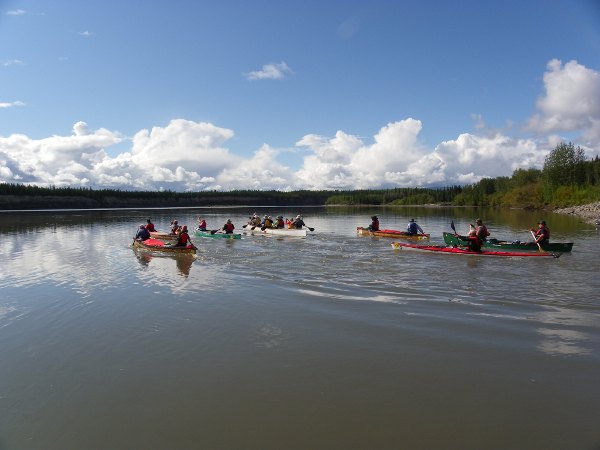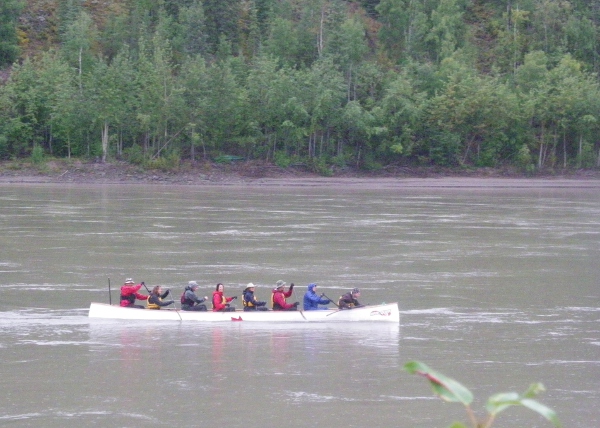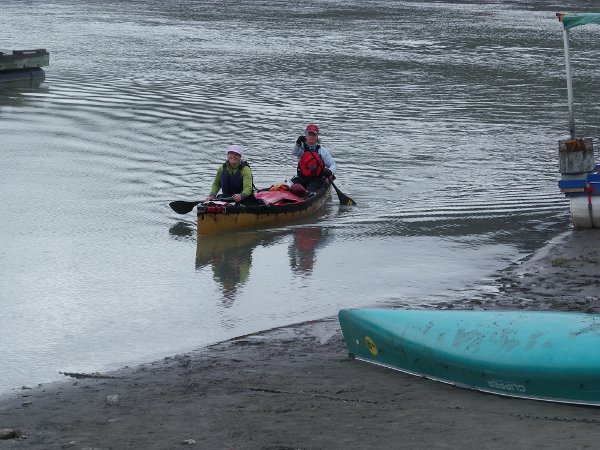The Story of the 2011 Yukon 360

To describe the 2011 Discovery Day weekend as "bit wet" would be an understatement. The weather forecast on Friday said "70% chance of showers". What it did not say was that the other 30% was for torrential rain. This meant that the third running of the Yukon 360 canoe and kayak race was a test of people, their equipment and their fortitude.
The 360 is a canoe race that is designed to fit in the three day Discovery Day weekend, so is typically about 300Km long. To make the race more entertaining, it is held on a different river each year. The first 360, in 2009, was on the Teslin and Yukon rivers from Johnson's Crossing to Carmacks and was marked by the still hot residue of forrest fires and very strong head winds. Last year, the race was on the Pelly River from Faro to Pelly Crosing and was marked by very hot conditions as the temperaures rose above 30C. This year it was on the Stewart and Yukon Rivers and was marked by rain. And more rain.
Four teams dropped out just before the race started citing various health concerns: there has been a fairly aggressive cold doing the rounds, and those were all probalby wise decisions. This was not a trip designed for nursing a cold. The remaining Seven teams, including an Ontario team in a beautiful home-made voyageur, and teams from Germany, Alaska, Florida and the Yukon, assembled in Mayo on a wet Saturday in a steady rain. Almost miraculously the rain stopped and it stayed mostly dry for the first day of paddling.
There are two Big Rules on the 360. One: you must be tracked by a Spot device, and two: you must stop for at least eight hours each night and remain stopped between 11pm and 5am, when it is dark this time of year. It was on the first of these overnight stops that the weather really turned nasty. The front of the pack had made good time down the Stewart and camped just past the McQuestern River, with the rest of the fleet spread out behind them. That night it poured with rain - the sort of rain that will find its way into anything that is not perfect. Tents leaked, sleeping bags got damp, cook boxes filled with water. All the sorts of things that can make camping miserable.

But this was a race, so there was little or no time to dry things out, and right on time in the morning the teams were back on the river, wet or dry. Mostly wet, as the unfriendly weather continued unrelenting. The weather did vary some during the day. We had light rain, heavy rain, torrential rain, in-your-face rain and head winds, with the occasional respite of merely threatening rain.
As the day went on it became apparent that no team was going to reach Dawson on the Sunday night, which meant that all that wet camping gear had to be used for a second night, and the competors had to reach into the bottom of their bags for their last items of less wet clothes. The leaders stopped for the night about 50 to 60Km out of Dawson, with the tail reaching back to just before the Stewart-Yukon confluence.
Sunday dawned early and wet for the teams and they padldled in heavy rain and headwinds into Dawson.
Was it fun? "In about 2 weeks I will have enjoyed it" said one paddler.
The race was not without incident. One of the Competitors had a Spot device that failed in a very unforunate way. On the Sunday morning it contrived to switched from Track mode (where the device sends an "I'm here" message every 10 minutes) into Help mode (where it sends an "I'm here and I have a problem" message every 10 minutes), and then, after about an hour, stopped transmitting. This caused some consternation. The Spot device has three sort of messages it can send: the OK or Track message, the Help message, and a Panic mode, which is sent directly to an emergency dispatch service where it is then relayed to the RCMP. This was not a Panic message, but the team's emergency contact was quite reasonably concerned. The race organisers reassured them that this was more likely a device failure than anything else, as the competitor in question was an accomplished kayaker and experienced outdoorsman, had been making good progress down the river while sending the help messages and because Spot data from other paddlers showed that he was not alone on the river while he was sending those messages, but the RCMP was called nevertheless when it was clear he was not sending any more messages.
As it happened, the Paddler had been right by the McQuestern Airstrip, where there is road access to the river, when the last Help message was sent, and a car and boat were dispatched from Dawson. The officers determined that a boat had recently landed and left (which was indeed the paddler in question). They put their boat in the water and went downstream for a reasonable distance to find a boat in distress (knowing when the boat had been transmitting a help message), found nothing and took no further action.

On the Monday, as soon as the canoe that had passed the allegedly distressed kayaker reached Dawson, the race organisers discovered that he had indeed had problems with his Spot device and was not otherwise in trouble. The organisers reported this immediately to his emergency contact and to the Mounties, who closed the incident. However, they were still very happy to see the man himself when he paddled into Dawson safe and sound an hour or so later. The safety of the race is premised on the Spot devices and it is unfortunate when there is no information from a boat. In any case, knowing that there is that panic button available provides invaluable piece of mind to those following their loved ones back home. Even in this instance, the fact that the last Spot messages received from the solo Kayaker were Help messages, not Panic, provided some comfort that while we did not know exactly what was happening on the river, at least we knew he was not in immediate danger.
All the paddlers encountered equipment failures of one sort or another, or discovered shortcomings in their equipment lists: "If you stop learning, you stop living" was how one paddler put it. It was a challenging race, but that did not come as a surprise to anyone. All seven teams who started the third annual Yukon 360 Canoe and Kayak Race completed the course, and while it may have been a little wetter than they would have liked this year, many of the paddlers will be back for the 360 next year, and the two teams that were in to qualify for entry to the Yukon 1000 had a real test and showed their mettle.
